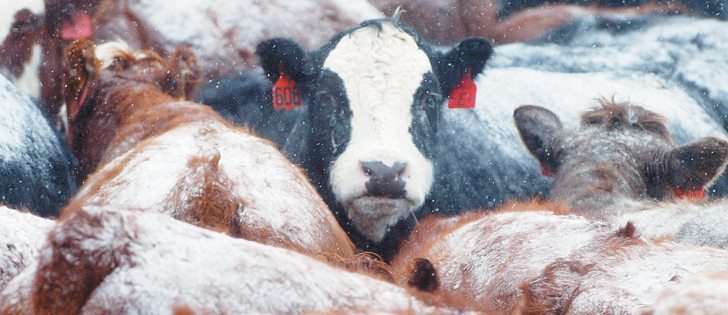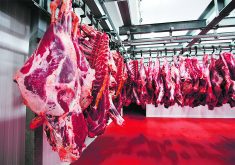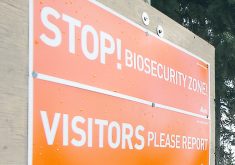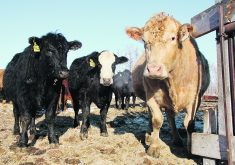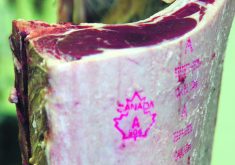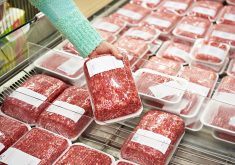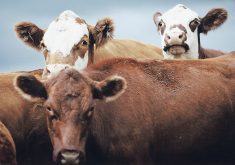Gaps in Canada’s early feed ban that allowed specified risk material from cattle to get into feed might have caused the country’s latest BSE case.
Paul Mayer, vice-president of policy and programs with the Canadian Food Inspection Agency, said the feed ban that was implemented in 1997 was not as comprehensive as the enhanced feed ban in 2007.
Specified Risk Materials, or SRMs, are tissues thought most likely to be infection points for BSE.
“It is possible between 1997 and 2007 that certain tissues that were not restricted in 1997 could have the potential to pose a risk,” he said during a Feb. 13 news conference following the announcement of Canada’s 19th case of BSE.
Read Also

Manitoba community projects get support from HyLife
HyLife Fun Days 2025 donated $35,000 each to recreation and housing projects in Killarney, Steinach and Neepawa earlier this fall.
“That is why the extension of the feed ban in 2007 was undertaken to eliminate those tissues from the feed supply.”
Mayer said no part of the animal’s carcass entered the human food or animal feed systems, and there is no risk to food safety.
At press time Feb. 13, the CFIA investigation into how the northern Alberta beef cow became infected with the brain wasting disease was continuing. It is trying to find the exact age of the cow and other animals that may have been exposed to the same feed as the infected animal in the first year of its life.
“As our investigation unfolds, we will seek to trace the animal back through its lifetime to seek to confirm its birth records,” said Mayer.
“Equivalent risk animals will be ordered destroyed, and they will be tested for BSE.”
Mayer said the farm where the animal was discovered is under quarantine. It is not a large herd.
The cow, which tested positive Feb. 11, was not born on the farm.
It was discovered during the BSE surveillance testing program.
The age of the cow will determine the impact on Canada’s livestock industry.
There will be little impact if the cow is older than 11.
However, Dennis Laycraft, executive vice-president of the Canadian Cattlemen’s Association, said Canada will no longer be able to apply to the World Organization for Animal Health (OIE) to change Canada’s status from “controlled BSE risk” to “negligible” if it is younger than 11.
“If it is less than 11 years it will push the clock back for us,” said Laycraft.
“We do know the normal incubation period is four to seven years. That would be outside the normal odds on this. We are not going to speculate.”
Under the OIE criteria, a country can be categorized as negligible risk if it has never had a case of BSE in a domestic animal or if infected animals were born more than 11 years ago.
Canada’s last confirmed case of BSE was reported in 2011 in a cow born in August 2004.
Canadian officials were only months away from applying for a change in the OIE risk status and had spent the winter encouraging producers to have their animals tested. Canada is required to test 30,000 head each year as part of the surveillance program.
Despite ongoing testing for BSE in cattle, Laycraft said they were still surprised with the discovery of the positive animal.
“All of us were very surprised. I have studied this enough to know there have been examples of these animals showing up, so I knew that there was the possibility, but when it’s been four years since the last one, you certainly hope that was the last one we were going to see.”
CCA chair Dave Solverson was also surprised at the latest case.
“If it was an older animal, then my surprise won’t be as high. If it was five or six, then it will be a little more concerning to figure out where the source came from,” said Solverson.
The latest case will affect Canada’s application for the new OIE risk category, but it won’t have the same impact as the discovery of BSE in 2003, said Solverson.
“The world knows so much more about BSE and the controlling of it. It is not as scary as it was in (2003) when we didn’t know a lot about BSE.”
Canada’s livestock industry was thrown into chaos in 2003 when a northern Alberta cow tested positive for BSE, the country’s first homegrown case of BSE. Countries closed their borders to Canadian beef and cattle, which cost Canadians billions of dollars in lost markets.
Canada’s surveillance and testing program has improved dramatically since then, and all specified risk material has been eliminated from feed.
Mayer said all trading partners have been briefed on the latest discovery and updated on Canada’s BSE surveillance program.
“It is much too early in the investigation to tell whether this animal will have any impact on our target to see a negligible risk status for Canada,” said Mayer.
Under the surveillance program, owners of animals older than 30 months of age that fit one of the five risk categories are encouraged to have a veterinarian test them for BSE.
Slightly more than 27,000 animals in Canada were tested for BSE last year. The OIE requires Canada to test 30,000 animals a year, 10,000 of them from Alberta.
Federal agriculture minister Gerry Ritz said producers shouldn’t be nervous about the latest case.
“They are concerned that this popped us up as it does, but we will maintain our controlled risk status and trace this cow out and find out what happened,” he said.
“We don’t change from our controlled risk status that we enjoy right now so we don’t see this interfering with any of our trade corridors at this point in time.”
BSE timeline
1992: CFIA introduces a national BSE surveillance program.
1993: BSE identified in cow near Red Deer, originally imported from Britain in 1987.
1997: CFIA bans the use of specified risk material in cattle feed.
May 16, 2003: BSE identified in an eight-year-old cow sent to slaughter in January from a farm 180 kilometres northwest of Edmonton.
May 20, 2003: The case is confirmed by regulatory officials. Borders, including the U.S., are immediately closed to all live Canadian cattle. In the coming weeks, several ranches in Alberta, Saskatchewan and British Columbia are quarantined as a precaution and hundreds of cattle are slaughtered.
Dec. 23, 2003: U.S. announces that BSE is identified in one cow in Washington state.
April 18, 2004: U.S. lifts restrictions on the import of Canadian ground beef, bone-in cuts and offal from cattle younger than 30 months.
Dec. 29, 2004: U.S. announces that it will accept imports of live cattle younger than 30 months from Canada beginning March 7, 2005.
Dec. 30, 2004: Agriculture Canada says that preliminary tests have identified BSE in a 10-year-old dairy cow.
Jan. 11, 2005: CFIA identifies BSE case in a beef cow in Alberta, slightly younger than seven years old, born after the 1997 ban on SRM in feed.
Jan. 22, 2006: CFIA confirms a case of BSE in a six-year-old cross-bred cow in Alberta.
April 16, 2006: CFIA confirms a case of BSE in British Columbia.
June 26, 2006: CFIA announces a ban on SRM in all animal feed, pet food and fertilizers to take effect July 12, 2007.
July 4, 2006: CFIA confirms case of BSE in a mature cross-bred beef cow in Manitoba.
July 13, 2006: CFIA confirms case of BSE in a 50-month-old dairy cow in Alberta.
Aug. 23, 2006: The CFIA confirms a case of BSE in a beef cow between the ages of eight and 10 in Alberta.
Feb. 7, 2007: CFIA confirms case of BSE in a mature bull from Alberta.
May 2, 2007: CFIA confirms case of BSE in a 66-month-old dairy cow in B.C.
Dec. 18, 2007: CFIA confirms BSE case in a 13-year-old beef cow in Alberta.
Feb. 26, 2008: CFIA confirms BSE in a six-year-old dairy cow in Alberta.
June 23, 2008: CFIA confirms BSE case in five-year-old Holstein in B.C.
Aug. 15, 2008: CFIA confirms BSE case in six-year-old beef cow from Alberta.
May 15, 2009: CFIA confirms BSE in a six-and-a-half-year-old dairy cow in Alberta.
Feb. 18, 2011: BSE confirmed in six-and-a-half-year-old dairy cow in Alberta.
Feb. 13, 2015: BSE confirmed in a beef cow in northern Alberta.
Contact mary.macarthur@producer.com

